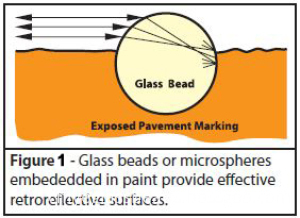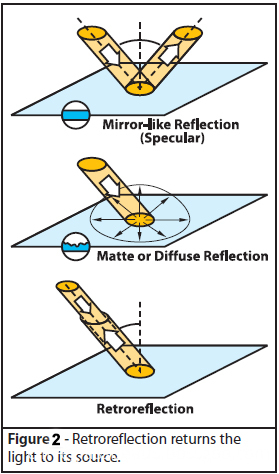| Payment Type: | L/C,T/T,D/P |
|---|---|
| Incoterm: | FOB,CFR,CIF |
| Min. Order: | 1 Ton |
Basic Info
Model No.: Reflective Glass Beads
Material: Glassbead
Application: Road Signs
Additional Info
Packaging: BULK-BAG
Productivity: 100,000MT
Brand: CHI YE GLASS BEAD
Transportation: Ocean
Place of Origin: CHINA
Certificate: ISO 9001/ISO 14001/CE/KS/JIS
Product Description
Glass Beads or Microspheres Embededded in Paint Provide Effective Retroreflective Surfaces
How to make Paint reflective with colesafety's Acrylic Paint and Reflective glass bead combo's?
Informative presentation showing examples of ways make and use reflective paint. Chiye Glass beads make Paint reflective.
Reflective Glass Beads for Pavement Markings 
Retroreflective highway signs and lane markers use special kinds of paints and materials. Most retroreflective paints and other pavement marking materials (PMM) contain many thousands of glass beads per square foot that are bonded to the highway with a strong binder. Instead of scattering light, as normal paints do, retroreflective paints containing glass beads turn the light around and send it back in the direction of your headlights. Figure 1 portrays how glass beads perform retroreflection.
For beads to retroreflect light, two properties are necessary: transparency and roundness. Beads made of glass have both of these properties.The need for transparency and roundness can be seen to be important if you follow the path of light as it enters a bead embedded in an applied roadway marking. The glass bead must be transparent so that light can pass into and out of the sphere. As the light ray enters the bead it is bent (refracted) downward by the rounded surface of the bead to a point below where the bead is embedded in the paint or PMM. Light striking the back of the paint-coated bead surface is reflected from the paint surface, with only a small fraction of the light going back toward the illumination source.
 How Glass Beads are Applied to Pavement Marking Materials
How Glass Beads are Applied to Pavement Marking Materials
The glass beads are applied to pavement marking materials in one of three ways. They can be premixed in marking materials before application, or they can be dropped or sprayed into the wet paint directly behind the paint sprayer, or a portion can be dropped onto premixed two-part epoxy or thermoplastic materials.
The top surface of beads is enveloped by the paint, with the wicking action of the paint rising up to above the midpoint of the bead. This provides two actions. It locks the glass beads into the paint and allows the paint to act as a diffuse reflecting surface for retroreflection, with the paint color affecting the color of the retroreflected light. The light entering the glass bead is bent and focused towards the back of the bead and reflected back out towards the headlights and driver.
A good application of beads results in the top layer of glass beads being embedded to about 60% of the diameter of the bead. There should be consistent quality of both glass beads and paint so that the paint thickness and bead coverage promotes even retroreflectivity across both directions of road travel. Too little paint results in under-embedded beads. This will result in improperly anchored beads that will fall out prematurely, and thus will not be effective retroreflectors. Under-embedded beads cause a large percentage of the light that enters them to exit out the back. Too much paint results in over-embedded beads. While over-embedded beads may remain in the binder, light cannot enter them and thus no retroreflection can occur.
The retroreflected light from glass beads is a function of three variables
Index of refraction of the glass beads
Bead shape, size, and surface characteristics
The number of beads present and exposed to light rays
Reflective Glass Beads Refractive Index (RI)
The bead`s Refractive Index (RI) is an important physical parameter.The higher the RI of the bead and the fewer impurities in the glass material, the more costly it is to manufacture.The RI is a function of the chemical makeup of the beads. The higher the RI, the more light is retroreflected. Beads used in traffic paint commonly have a RI of 1.5. There are some 1.65 RI 5 beads used with thermoplastics, and 1.9 RI beads are often used in retroreflective airport markings. Despite the increased brightness gained with the higher refractive index, most state and local highway agencies find it is more cost-effective to use 1.5 RI beads.
Glass beads range in size from 60 micrometers (0.0024 inches) to 850 micrometers (0.034 inches). Bead size is usually expressed in terms of U.S. sieve number, or the size of mesh screen that a bead will pass through. For example, a U.S. Sieve Number 20 will permit beads with a diameter of 840 micrometers (0.033 inches) or less to pass through the mesh, whereas a Number 200 mesh will allow only those beads of 74 micrometers (0.0029 inches) or less to pass. A typical application of drop-on beads will use from 20 to 100 mesh. The specified mix of bead size (called in the industry gradation) is usually a local policy decision based on several factors.
Uncertainties in material control: there is always some spread in the size of beads in any production run
Drying time of the marking material (affects settlement of beads in to the binder): a distribution of sizes assures that some of the beads will have an optimum binding in the marking material
Uncertainties of weather control: another factor affecting drying time
Service life requirements: as the pavement marker wears, beads that were too deep in the binder will increase in their retroreflectance ability
Number of beads applied: a mix of sizes increases the possible coverage.
Contact Person: Catherine Liu
Phone:86-0316-2201288
Fax:86-0316-2201289
Address: YIBEI INDUSTRY AND TRADE ZONE,CAOJIAWU,YONGQING COUNTY,Langfang,Hebei

Sweep wechat
© 2019 CHINA WAY. All Rights Reserved. CHIYE GLASS BEAD (HEBEI) CO., LTD, Inc. All rights reserved. site map. sitemap.html